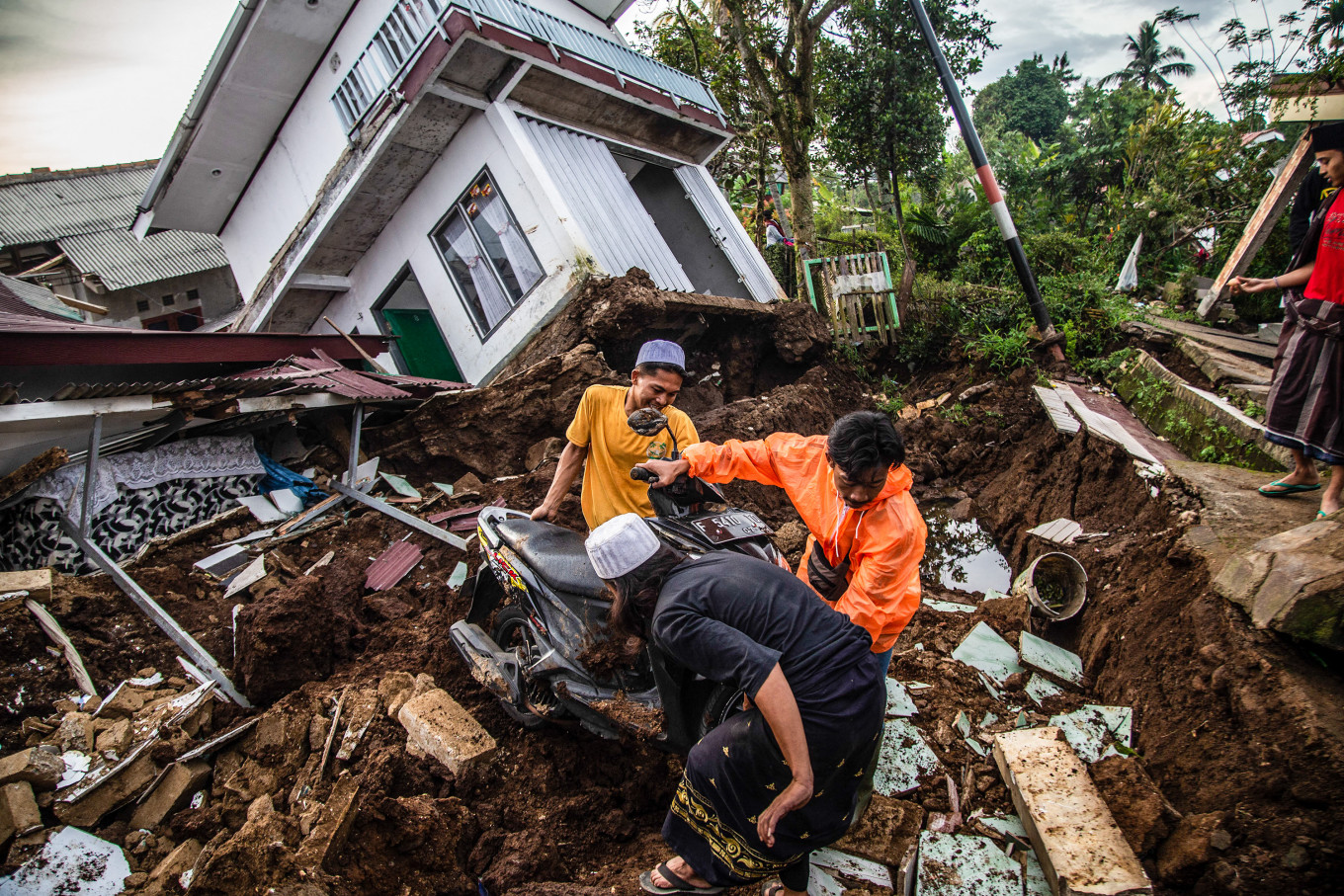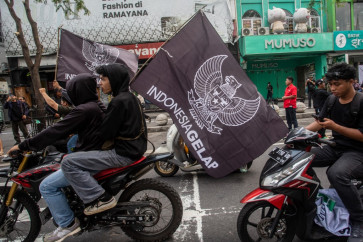Popular Reads
Top Results
Can't find what you're looking for?
View all search resultsPopular Reads
Top Results
Can't find what you're looking for?
View all search resultsCianjur quake points to disaster mitigation flaws
Disaster management experts say that the nation's policies need to incorporate lessons from Monday's Cianjur earthquake and shift their focus from mitigation to preparedness, with an emphasis on a bottom-up approach in local communities.
Change text size
Gift Premium Articles
to Anyone
T
he deadly earthquake that struck on Monday in Cianjur regency, West Java, has highlighted the shortcomings in the nation’s disaster preparedness, sparking calls for more disaster risk reduction at a time when policymakers have focused more on disaster response.
Located on the Pacific Ring of Fire, natural disasters are a common occurrence across the Indonesian archipelago. Data from the National Disaster Mitigation Agency (BNPB) show that over 3,000 natural disasters resulting in the deaths of more than 700 people were recorded in 2021 alone.
In 2018, more than 5,000 people lost their lives to natural disasters, the majority in the devastating 7.4-magnitude earthquake and tsunami that struck Palu, Central Sulawesi, in September.
As the death toll continues to rise with dozens still unaccounted for in the aftermath of the Cianjur quake, disaster management experts bemoaned that authorities seemed none the wiser.
Policymakers had yet to learn from the mistakes made in the wake of such disasters, said Muhammad Habib Dzakwan, a policy researcher at the Centre for Strategic and International Studies (CSIS), Jakarta.
He noted that the nation’s disaster policies leaned more toward offering stopgap solutions in disaster response, as opposed to investing in preventive measures to mitigate future risks.
“When a disaster occurs, our policymakers are more concerned with disaster response, not preparedness,” Dzakwan told The Jakarta Post. “What we need is political commitment […] from the government to prioritize continuity in addressing natural disasters.”
This lack of commitment had contributed to failed efforts in amending the country’s outdated 2007 Disaster Mitigation Law, as well as by local administrations in building adequate capacity for regional disaster mitigation agencies (BPBD), the disaster management expert said.
The Meteorology, Climatology and Geophysics Agency (BMKG) has an online platform that provides public information on potential natural disasters, but Dzakwan insists the government must also ensure that the country’s early warning system is effective.
“There needs to be concrete collaboration involving many parties,” he said. “The Communications and Information Ministry, for instance, also needs to play its part by ensuring that more people can access the internet.”
Structural integrity
Monday’s 5.6-magnitude quake has resulted in hundreds of lives lost and displaced people. It also destroyed buildings and infrastructure, cutting off access to roads, electricity, clean water and food.
BNPB chief Suharyanto told the press from his temporary field office in Cianjur that 272 people had been killed and 2,046 injured as of Thursday.
Following a site visit on Tuesday, President Joko “Jokowi” Widodo instructed the Public Works and Housing Ministry to lead the efforts to rebuild local houses that had been destroyed or damaged in the disaster and to ensure that the new buildings met the standards for earthquake-proof structures.
This last point is often underrated, experts say.
Saut Sagala of the Research Development Initiative (RDI) in Bandung, West Java, said authorities needed to incorporate the principles of urban planning in its disaster preparedness initiatives, particularly with regard to better supervision over building permits (IMB).
“When people apply for an IMB, the government should take into consideration [disaster risk] before agreeing to issue them,” Saut told the Post on Thursday. He also underlined that authorities also needed to conduct more inspections on the structural integrity of existing buildings.
Authorities have pointed to flawed construction as a major factor contributing to the high death toll. The Cianjur quake had caused varying levels of damage to more than 56,000 houses across 15 districts in the regency as of Thursday, official records showed.
Collective efforts
Meanwhile, with the top-down approach to national policies on disaster preparedness, Saut said local communities also needed to build collective awareness and capacity to anticipate worst-case scenarios.
“It is imperative for communities to have a bottom-up approach to disaster preparedness. Whether they receive aid from international NGOs or the government, [people] usually need to see proof that something is working” before implementing the programs locally, he said.
Community-based initiatives for disaster preparedness, he continued, should incorporate drills on what to do in the event of a disaster, including as part of the curriculum at local schools.
Robert Gass, the deputy representative of the United Nations Children’s Fund (UNICEF) Indonesia, told the Post on Thursday that Indonesia’s disaster preparedness and response could still be improved with a greater emphasis on children’s welfare, particularly as they were among the most vulnerable groups in a disaster.
“[Disaster preparedness] is always something of a work in progress, and that is not only an issue in Indonesia, but across the globe,” said Gass. “But in a country where disaster is common, children’s lives are always on the line. We have to make disaster plans centered on their needs.”
Daryono, the BMKG’s earthquake and tsunami mitigation head, said the country’s capacity in disaster mitigation was still limited due to different levels of public awareness on disaster risk reduction across disaster-prone areas.
“The availability of disaster mitigation educators is also limited. As such, some regional administrations are not yet aware what their areas should do to mitigate disasters,” he said on Wednesday.
The BNPB’s Suharyanto said the agency would continue to champion the pentahelix collaboration approach to improving Indonesia’s disaster preparedness, which involved synergy between multiple stakeholders in government, academia, the private sector, local communities and the mass media.
“Indonesia is a supermarket for natural disasters,” he told the Post on Wednesday.
“It will take time to increase people’s awareness that they live in a disaster-prone area. This is a tough task for all of us, not just for the BNPB.”










